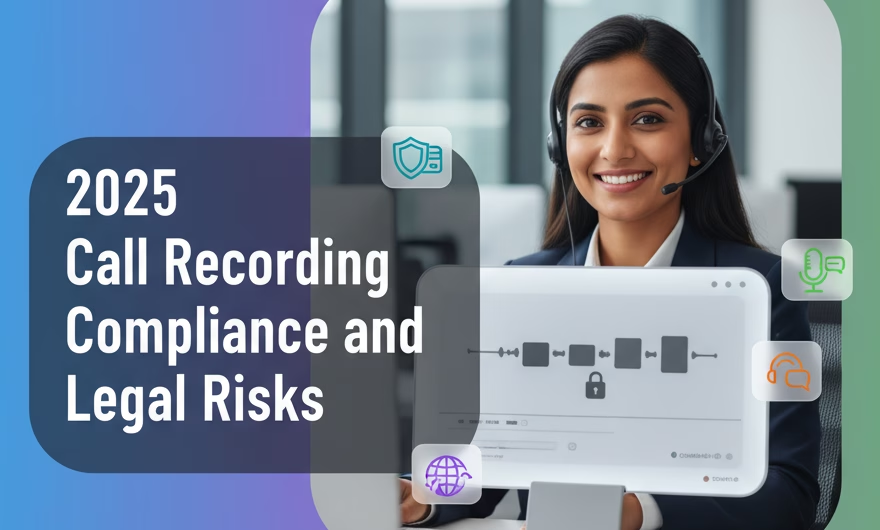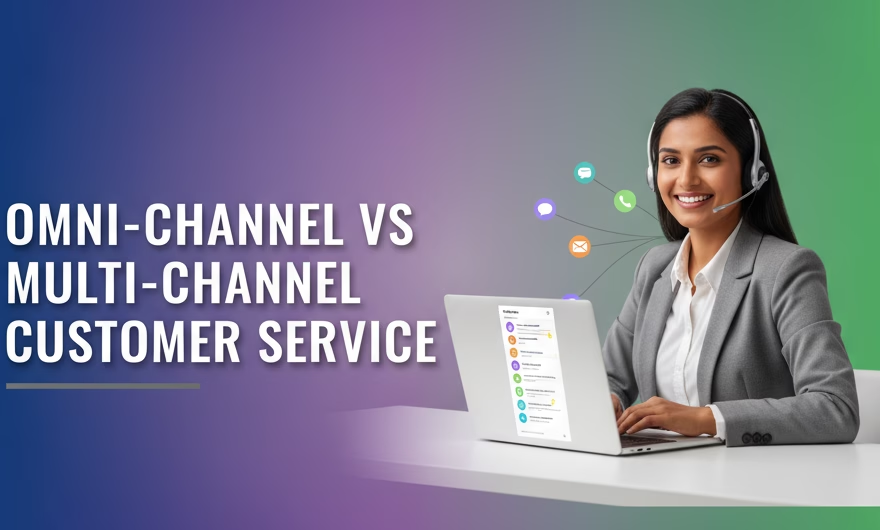Call recording in contact centers involves multiple compliance and legal challenges that organizations must navigate carefully. As of 2025, heightened privacy expectations, evolving standards, and stricter enforcement across regions mean businesses must treat call recording as a regulated processing activity—governed by data protection, financial, healthcare, telecom, and consumer laws—rather than a simple quality assurance tool.
Businesses must treat call recording as a regulated processing activity—governed by data protection, financial, healthcare, telecom, and consumer laws—rather than a simple quality assurance tool.
Key Compliance Issues:
- PCI Compliance:
Organizations handling payments must adhere to PCI (Payment Card Industry) Data Security Standard requirements to ensure cardholder data security. A critical rule is never to store the CVV2 (the three- or four-digit card verification code) after authorization. This applies to any medium, including voice recordings. To comply, call recordings should be paused when customers provide the CVV2 and resumed afterward to avoid capturing this sensitive data.
As of 2025, PCI DSS v4.0 is in effect, with several “future-dated” requirements now active. For contact centers, practical implications include:
- Ensuring recordings do not capture sensitive authentication data (e.g., CVV2). Use pause-and-resume or DTMF tone masking to keep sensitive tones out of the recording stream.
- Minimizing exposure of Primary Account Numbers (PAN). If PANs are present for legitimate business reasons, mask them in playback and transcripts, encrypt data at rest and in transit, and restrict access by role.
- Maintaining audit trails and access logs for any playback or export of recordings that may contain cardholder data.
- Applying data retention limits and defensible deletion, aligning with business need and regulatory requirements.
These controls reduce scope, limit risk, and demonstrate due diligence during assessments.
- Outgoing Notification and Consent:
Contact centers record both incoming and outgoing calls, but outbound calls often miss a clear pre-recording notice. This omission fails to offer customers an option to consent or disconnect before the recording starts. Best practices include always notifying callers when their calls are recorded and offering an alternative (such as speaking to an unrecorded line for sensitive details, using secure IVR for payments, or supplying a different channel for identity verification).
Consent and disclosure expectations vary by jurisdiction:
- United States: Federal law generally allows one-party consent to record, while several states (including California and Pennsylvania) require all parties to consent. To simplify operations, many businesses standardize on an all-party notification across both inbound and outbound calls.
- European Union/UK: Under GDPR and the UK GDPR, you must identify a lawful basis for recording (e.g., consent, contract necessity, legal obligation, or legitimate interests), provide clear notice, and respect individual rights (access, deletion, restriction). Consent, when used, must be freely given, specific, informed, and revocable.
- Other regions: Privacy laws in countries like Australia and Canada generally require clear disclosure when calls are being recorded and place obligations on storage, security, and cross-border transfers.
As of 2025, several US state privacy laws and the California Privacy Rights Act reinforce the need for transparent notices “at collection,” data minimization, and honoring consumer requests. Harmonizing your scripts and IVR announcements to the most stringent markets you serve helps you operate consistently and lowers legal risk.
- ‘Barge’ and ‘Whisper’ Features:
In some contact centers, supervisors can listen in on calls (“barge”) or whisper instructions to agents without the customer’s knowledge. In certain jurisdictions like California, monitoring without prior consent is prohibited. If your operation uses live monitoring, your recording notification should clearly state that calls may be recorded and monitored for quality and training purposes—not just “recorded.”
To use these features compliantly and responsibly:
- Disclose monitoring and coaching in your pre-call message and agent scripts; ensure the notice is played or read before recording/monitoring begins.
- Enable visible indicators to agents when whisper/barge is active to prevent covert monitoring beyond policy.
- Restrict the ability to barge/whisper to authorized supervisory roles, and log all monitoring sessions for audit.
- Apply least-privilege access, multi-factor authentication for supervisors, and periodic reviews of who can monitor calls.
Clear disclosures, guardrails, and auditable controls help align live monitoring with privacy and wiretapping laws.
- Legal Compliance Across Jurisdictions:
Call recording laws vary by country and even by states within countries, notably in the US, where both federal and state laws apply. Failure to comply can lead to fines, statutory damages, injunctions, and reputational harm. A coordinated compliance framework should consider:
- United States: The federal Wiretap Act permits one-party consent, but state-level all-party consent rules can apply. Telemarketing activities are also governed by the Telemarketing Sales Rule and the Telephone Consumer Protection Act, which impose additional disclosure and consent requirements for certain calls and technologies.
- European Union: GDPR and the ePrivacy Directive govern call recording, requiring a lawful basis, transparency, purpose limitation, data minimization, security, and time-bound retention. Data Protection Impact Assessments may be necessary for large-scale or systematic monitoring.
- United Kingdom: UK GDPR mirrors GDPR principles. Financial services firms are subject to FCA rules derived from MiFID II, which require recording of certain in-scope communications and retention—commonly five years and up to seven years upon request by authorities (as of 2025).
- Sectoral rules: Healthcare entities in the US must safeguard Protected Health Information on recordings under HIPAA, with appropriate administrative, physical, and technical controls and Business Associate Agreements where vendors are involved.
- Cross-border transfers: When recordings or transcripts leave their country of origin (for storage, QA, AI analytics, or support), ensure appropriate transfer mechanisms (such as standard contractual clauses where applicable) and conduct transfer risk assessments.
Given these variations, organizations should map the jurisdictions they operate in, standardize notices to the highest bar where practical, and maintain documented policies, retention schedules, and vendor due diligence to demonstrate accountability.
Understanding and following government-issued call recording laws and regulations promulgated by standards bodies and sectoral agencies is crucial to avoid legal risks and maintain stakeholder trust. Beyond the core issues above, several foundational practices help operationalize compliance:
Operationalizing Compliance: Foundational Practices
- Privacy by design: Decide why you record before you record. Limit recording to the minimum scope needed for quality, training, compliance, or dispute resolution. Where feasible, record segments rather than entire calls, and exclude highly sensitive moments.
- Transparent notices: Use consistent, plain-language disclosures across inbound IVR messages, outbound dialer scripts, and agent intros. If monitoring is in use, state “recorded and monitored.” Offer a path to opt out or use an alternative channel for sensitive information.
- Security and access control: Encrypt recordings at rest and in transit, implement role-based access, enforce MFA, and monitor access with detailed logs. Review access rights regularly and revoke promptly when roles change.
- Data minimization and retention: Set retention by purpose and law. For example, financial-recording obligations (such as MiFID II in the EU/UK) may require multi-year retention, while general QA may justify shorter periods. Delete recordings defensibly when retention ends, and document exceptions.
- Redaction and masking: Use pause/resume, DTMF suppression, or automated redaction to prevent sensitive data (CVV2, full PAN, government IDs, health data) from entering recordings and transcripts.
- Rights management: Prepare workflows to honor data subject requests (access, deletion, restrictions) where applicable. Keep an index of recordings to locate an individual’s data efficiently without exposing unrelated recordings.
- Vendor governance: If third parties store, transcribe, or analyze recordings, execute appropriate agreements, confirm certifications where relevant, and review their controls and sub-processor lists. Ensure they can support your retention and deletion needs.
- Training and audits: Train agents and supervisors on scripts, notification requirements, and how to handle sensitive moments (e.g., moving to secure IVR for payments). Periodically audit recordings and logs to validate that notices, controls, and retention are working as intended.
This overview highlights the importance of awareness and strict adherence to legal frameworks when implementing call recording in organizations. By embedding PCI-compliant capture methods, clear all-party notifications, explicit disclosures for monitoring features, and region-specific requirements into everyday operations, contact centers can reduce legal exposure, build customer trust, and preserve the business value of recorded interactions—confidently and compliantly, at scale.




